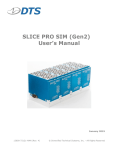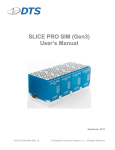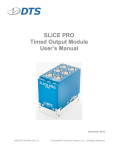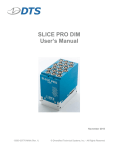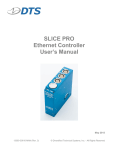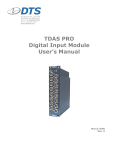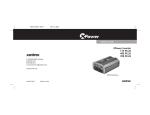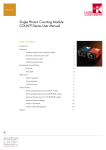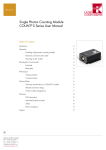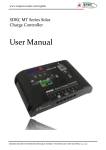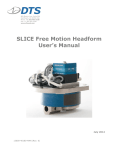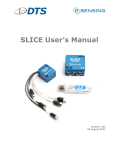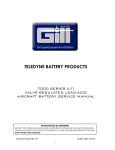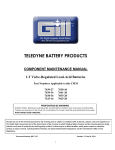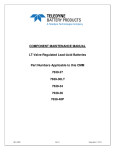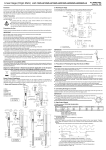Download SLICE PRO SIM User`s Manual - Diversified Technical Systems
Transcript
SLICE PRO SIM User’s Manual January 2014 13000-72121-MAN (Rev. 1) ©Diversified Technical Systems, Inc. - All Rights Reserved SLICE PRO SIM User’s Manual January 2014 Table of Contents DTS Support .................................................................................................... 4 Introducing the SLICE PRO SIM ...................................................................... 5 Overview of SLICE PRO SIM Features ............................................................. 5 Sensor Connectors ..........................................................................................5 Supported Sensor Types ..................................................................................6 Input Range ................................................................................................6 Excitation Sources .......................................................................................7 Bridge Completion .......................................................................................7 Hardware Filters ..........................................................................................7 Offset Compensation ....................................................................................7 Sensor ID ...................................................................................................7 Shunt Emulation ..........................................................................................7 Sampling Rates ...............................................................................................8 Memory Size ...................................................................................................8 UP/DOWN Interface Connectors ........................................................................8 LEDs ..............................................................................................................8 Basic Care and Handling ................................................................................. 9 Shock Rating ................................................................................................ 10 Mounting Considerations ............................................................................. 10 Thermal Considerations .................................................................................. 10 Communication Features .............................................................................. 11 Data Collection Concepts............................................................................... 12 Data Collection Modes .................................................................................... 13 Circular Buffer Mode................................................................................... 13 Recorder Mode .......................................................................................... 13 Hybrid Recorder Mode ................................................................................ 13 Continuous Recorder Mode.......................................................................... 13 Start Record and Event Initiation ..................................................................... 13 Appendix A: Connector Information ............................................................. 15 Appendix B: Mechanical Specifications ......................................................... 16 Appendix C: SLICE PRO SIM Sensor Connections ......................................... 17 [email protected] ii 13000-72121-MAN (Rev. 1) SLICE PRO SIM User’s Manual January 2014 Appendix D: How to Calculate Data Storage Duration .................................. 19 [email protected] iii 13000-72121-MAN (Rev. 1) SLICE PRO SIM User’s Manual January 2014 DTS Support SLICE PRO systems are designed to be reliable and simple to operate. Should you need assistance, DTS has support engineers worldwide with extensive product knowledge and test experience to help via telephone, e-mail or on-site visits. The best way to contact a DTS support engineer is to e-mail [email protected]. Your e-mail is immediately forwarded to all DTS support engineers worldwide and is typically the fastest way to get a response, particularly if you need assistance outside of normal business hours. For assistance by telephone, please go to http://dtsweb.com/support/techsupport.php to find the phone number appropriate for your region of the world. Additional self-help resources and support material can be found at www.dtsweb.com. All DTS software installs user manuals to support a variety of products; these are available under the Help menu. This manual supports the following products: 13000-72121: SLICE PRO SIM (9 ch), 100k, 200k filters (Option 21/Tajimi) 13000-72139: SLICE PRO SIM (9 ch), 100k, 200k filters (Option 39) 13000-72221: SLICE PRO SIM (18 ch), 100k, 200k filters (Option 21/Tajimi) 13000-72239: SLICE PRO SIM (18 ch), 100k, 200k filters (Option 39) 13000-75121: SLICE PRO SIM (9 ch), 50k, 100k filters (Option 21/Tajimi) 13000-75139: SLICE PRO SIM (9 ch), 50k, 100k filters (Option 39) 13000-75221: SLICE PRO SIM (18 ch), 50k, 100k filters (Option 21/Tajimi) 13000-75239: SLICE PRO SIM (18 ch), 50k, 100k filters (Option 39) 13000-75242: SLICE PRO SIM (18 ch), 50k, 100k filters (Option 42) [email protected] 4 13000-72121-MAN (Rev. 1) SLICE PRO SIM User’s Manual January 2014 Introducing the SLICE PRO SIM The SLICE PRO Sensor Input Module (SIM) is a high-speed, high-performance, industrial data acquisition system. The system is configurable and is supplied with either 9- or 18-channels. The SLICE PRO SIM supports many sensor types and sensitivities, interfacing with common and not-so common sensors. This manual discusses the features and options available with the SLICE PRO SIM. To identify the specific hardware included with your system, please see your packing list. Overview of SLICE PRO SIM Features Sample rates up to 1 Msps on 9 channels simultaneously. Shock hardened to 100 g for dynamic testing environments. 9 or 18 sensor input channels, each with isolated excitation, high impedance differential input amplifier, and automatic sensor identification circuits. Internal battery with 1 hour capacity functions as primary or back-up power. LED indicators for power and system status. Easy control with the SLICE PRO USB Controller or SLICE PRO Ethernet Controller. Chainable with up to three other SLICE PRO modules. Each channel supports conventional bridge sensors or IEPE sensors. Connector information and pin assignments can be found in Appendix A. Mechanical specifications are included in Appendix B. Appendix C provides typical sensor connection diagrams. Appendix D provides information on how to calculate data storage duration. Sensor Connectors The SLICE PRO SIM is available with LEMO 1B or Tajimi 7-pin sensor input connectors. See Appendix C for pin assignments and detailed sensor connection information. (18-channel SLICE PRO SIMs are shown; 9-channel units are also available.) [email protected] 5 13000-72121-MAN (Rev. 1) SLICE PRO SIM User’s Manual January 2014 Supported Sensor Types The SLICE PRO SIM supplies 2 V and 5 V excitation up to 20 mA and supports many types of sensors including accelerometers, load cells and pressure sensors. The following general sensor types are supported: Full (4-wire) or half-bridge (2- or 3-wire) resistive and piezo-resistive types. Voltage input: Input range 0.1 to 4.9 V; larger ranges with voltage expander circuit. Conditioned sensors with 5 V excitation and 2.5 V centered signal output. Common piezo-electric sensor types, including accelerometers, microphones and other charge-type sensors. Common sensor configurations are shown in Appendix C. If you have further questions regarding what sensors are supported, please contact [email protected] and provide the sensor manufacturer and model number, if available. SLICE PRO SIM Single Channel Block Diagram Input Range The nominal sensor input range is ±2.4 V at a gain of 1. At higher gains, the maximum range decreases correspondingly. For example, at a gain of 10, the input range is ±240 mV. (SLICEWare will automatically calculate the gain based on the user-specified input range and other sensor parameters.) The nominal input range for an IEPE sensor is 0-24 V (±12 V) at unity gain. As with bridges, at higher gains, the input range decreases accordingly. For example, when the SLICE PRO unit applies a gain of 100, the input range will be 100 times smaller, or ±120 mV. [email protected] 6 13000-72121-MAN (Rev. 1) SLICE PRO SIM User’s Manual January 2014 Excitation Sources The excitation source for each channel is individually controlled and isolated. Excitation sources are not turned on until the software initializes the system during diagnostics. The bridge excitation can be set at 2.0 V or 5.0 V. The constant current IEPE excitation is fixed at 4.2 mA. Bridge Completion Bridge completion for any channel may be selected via SLICEWare. When chosen, a precision half-bridge is connected across +Ex, -Ex and +Sig. Therefore, half-bridge transducers should be connected to ±Ex and -Sig. The value of bridge completion resistors is 3,000 ohms, ±0.1%. Hardware Filters Each measurement channel has a 4-pole Butterworth anti-aliasing filter with one selectable –3 dB knee point. Two filter combinations are available: 50 kHz and 100 kHz, or 100 kHz and 200 kHz. Each channel also has a software-controlled, variable 5-pole Butterworth filter used in conjunction with the 4-pole Butterworth filters at lower sampling rates. SLICEWare automatically chooses the best filter setting for a given sampling rate. The relationship between sampling rate and anti-alias filter frequency is defined in the software configuration files. Please see the SLICEWare software manual for additional information. Offset Compensation Each channel can compensate for a sensor offset of up to 200% of the full-range output of a sensor. The sensor offset is measured and the hardware compensation is adjusted during SLICEWare’s diagnostic check. Please see the SLICEWare software manual for additional information. Sensor ID Each measurement channel supports communication with silicon serial number devices manufactured by Dallas Semiconductor/Maxim Integrated Products for both bridge and IEPE sensors. When an ID chip is connected to the proper pins on the sensor connector, SLICEWare can automatically read these devices and correlate the serial number to channel set-up information stored in a Sensor Information File (SIF). (Note that sensor ID for IEPE is typically integrated into the sensor using the existing twowire interface, and do not require a separate pin.) Shunt Emulation SLICE PRO SIM channels contain a shunt emulation circuit, effectively eliminating the need for conventional shunt resistors to perform shunt checks. When “Emulation” is chosen as the shunt calibration method within SLICEWare, the software injects a precisely-calculated current into the sensor to create an expected deflection of the sensor's output. This current, or voltage source, is a digital-to-analog converter (DAC) that allows the shunt emulation circuit to function as a shunt resistor. DAC settings are automatically calculated by the software to simulate 70-80% of the full-scale of the analog-to-digital converter. Please see the SLICEWare software manual for additional information. [email protected] 7 13000-72121-MAN (Rev. 1) SLICE PRO SIM User’s Manual January 2014 Sampling Rates The SLICE PRO SIM has user-selectable sampling rates up to 1 Msps. The available gains on any given channel are dependent on the sampling rate chosen by the user. The widest range of gains occurs at low sampling rates; the narrowest range of gains occurs at the highest sampling rates. If a sampling rate is selected that does not support the range and sensitivity of a particular sensor/channel combination, the software will alert the user. The following table shows the available gain ranges for three sampling rates, assuming the default 1:5 AAF-to-sampling rate ratio. Input Range (Bridge) Sampling Rate 1 Msps 12.5-500 mV 500 ksps 3.9-1250 mV 200 ksps and below 0.39-2500 mV Input Range (IEPE) ±120-12000 mV (gain of 1-100) Memory Size With 16 GB of flash memory (15 GB available for data storage), the SLICE PRO SIM can record ~14 minutes of data at the maximum sampling rate (9 channels at 1 Msps or 18 channels at 500 ksps). Since the recording capacity is very large, it is generally best to limit sampling rates and event durations to the minimum necessary to avoid large and cumbersome data files. Large files take longer to download and may also be time-consuming to post-process or difficult to share. Use of the Region of Interest (ROI) download can save a great deal of time if implemented properly. For information on how to calculate recording duration, please see Appendix D. UP/DOWN Interface Connectors The UP interface connector allows the user to interface to either 1) a SLICE PRO Controller or other support interface, or 2) another SLICE PRO module. The DOWN interface connector allows the user to interface to another SLICE PRO module. Please see Appendix A for pin assignments. LEDs The SLICE PRO SIM has two LEDs. The status LED is red, green or blue and indicates communication and arm status. The power LED is red, green or blue and indicates power status. At system power up, the red-green-blue LED initialization sequence is performed by the status LED followed by the power LED. LED behavior is summarized in the tables below. [email protected] 8 13000-72121-MAN (Rev. 1) SLICE PRO SIM User’s Manual January 2014 State LED Condition Power up Communicating with PC (not armed) Recorder Mode State Circular Buffer Mode Armed and waiting for Start Record signal to begin data collection Start Record signal received; recording data Armed and recording data; waiting for Event signal Event signal received (optional) Event signal received Data collection completed Data collection completed System Power ON* LED Condition System Power OFF Power up Connected to external power and unit is charging (power OK) Connected to external power and unit has fully charged Connected to external power; power fault Communication active with upstream module * These transitions do not happen if the unit is armed. Basic Care and Handling The SLICE PRO systems are precision devices designed to operate reliably in dynamic testing environments. Though resistant to many environmental conditions, care should be taken not to subject the unit to harsh chemicals, submerge it in water, or drop it onto any hard surface. WARNING: Electronic equipment dropped from desk height onto a solid floor may experience as much as 10,000 g. Under these conditions, damage to the exterior and/or interior of the unit is likely. The SLICE PRO SIM is supplied with calibration data from the factory. DTS recommends annual recalibration to ensure that the unit is performing within factory [email protected] 9 13000-72121-MAN (Rev. 1) SLICE PRO SIM User’s Manual January 2014 specifications. The SLICE PRO SIM is not user-serviceable and should be returned to the factory for service or repair. When not in use or if shipping is required, we suggest that you always place the unit in the padded carrying case originally provided with your unit. Shock Rating The SLICE PRO SIM is rated for 100 g, 12 msec half-sine duration, in all axes. Mounting Considerations The unit should be securely bolted to the test article or dynamic testing device to provide the best shock protection. Mounting methods and hardware selection should be carefully calculated to withstand expected shock loading and facilitate proper grounding. Check bolt tightness periodically to ensure that 1) the unit is securely fastened to the baseplate, and 2) the baseplate is securely fastened to the testing platform. (See Appendix B for the unit’s mechanical specifications.) Thermal Considerations The SLICE PRO systems are low power devices with negligible self-heating and it is unlikely that self-heating will be an issue in real-world testing. Should you have any questions about using SLICE PRO in your environment, please contact DTS. Power Management A good power source is of paramount importance. SLICE PRO SIMs should be powered from a SLICE PRO Controller. (One Controller can support up to 4 SLICE PRO modules.) Be sure to consider any power drop due to cable length. SLICE PRO Controller Input Voltage, System OFF/ON Input Current, System OFF* Input Current, System ON** 11.5-16 VDC 500 mA per module*** 1 A per module*** * charging all internal batteries ** fully armed + charging all internal batteries *** Controllers are considered modules for the purposes of power calculations. Power Consumption Power off: When connected to sufficient external power, the SLICE PRO SIM will draw up to 500 mA for charging the internal battery. Power on: When the SIM is initially powered, all sensor excitation sources, calibration circuitry, signal conditioning sources, adjustable filter circuits are in a shutdown state. When the user runs a test set-up, the software automatically energizes these circuits. The current draw per module will increase from ~625 mA to as much as 1 A when the system is fully armed and powering 350 ohm bridges with 5 V excitation. During data collection: Once the system has been armed for data collection, all circuits remain in a full power state until data collection is finished. After the data [email protected] 10 13000-72121-MAN (Rev. 1) SLICE PRO SIM User’s Manual January 2014 collection routine has completed, the SIM de-energizes the signal conditioning, excitation and filter circuits to minimize power consumption. Internal Battery The SLICE PRO SIM contains an internal 7.4 V (nominal) lithium battery that operates as primary power or back-up power should primary power fail. When fully charged, battery capacity is sufficient to provide primary power and sustain full operation for 1 hour. It charges whenever sufficient external power is connected to the module via a SLICE PRO Controller. The maximum charge time is 3-4 hours from complete discharge to full capacity. The module does not need to be ON in order to charge the internal battery. Charging practices can affect the useful operational life of the battery. In addition to good charging habits, conditioning the battery may be useful—three deepdischarge/recharge cycles may help increase battery performance. The battery’s useful capacity is greatly shortened near the end of its service life and should be replaced when it has decreased to 50% of its initial capacity. The battery is not userserviceable and should be returned to the factory for battery replacement. Power-up and Power-down Procedures The SLICE PRO SIM is powered up when the proper signal is connected at the UP interface connector. This is typically accomplished via a SLICE PRO Controller. Powerup of the module takes 5 seconds to 2 minutes (this depends greatly on the type of Controller in use), after which communication is enabled. To restart, turn off the system and wait ~30 seconds before reinitializing. If a system is armed for data collection, it will remain on until it is disarmed or power reserves are exhausted. An incomplete power-down/power-up cycle can result in errors, so be certain to follow proper procedures. Communication Features Communications with the SLICE PRO SIM is accomplished via 1) a SLICE PRO USB Controller and USB comm cable (USB A to USB B) or a SLICE PRO Ethernet Controller and Ethernet (REC) comm cable (P/N 10700-0015x), and 2) a PC running SLICEWare version 1.08 or higher. Please see the SLICE PRO USB Controller or SLICE PRO Ethernet Controller User’s Manuals for additional information. [email protected] 11 13000-72121-MAN (Rev. 1) SLICE PRO SIM User’s Manual January 2014 SLICE PRO Ethernet Controller COM A and COM B - Functionally identical - To PC via REC cable (P/N 10700-0015x) - Supports Ethernet 10/100BaseT/ Tx communications - Compatible with all TDAS and SLICE PRO COM connectors ON/PWR pushbutton switch - Cycles power ON/OFF - Momentary; press and hold for 2 sec SLICE PRO SIM (sensor input connectors) Power Input USB communications - To PC via standard USB A-B cable SLICE PRO USB Controller SLICE PRO System Set-up Data Collection Concepts The discussion below provides a general introduction to data collection. Please see the SLICEWare 1.08 User’s Manual for a detailed discussion and implementation specifics. SLICE is a standalone data logger. Once the system is armed, the PC can be disconnected if desired. After receiving a Start Record or Event signal, SLICE autonomously collects data, storing it to flash memory with no user interaction. After the test, the user can reconnect the PC to download the data. There is also a real-time mode in the control software that allows the user to check channel inputs on an oscilloscope-looking screen. (This data can be logged.) [email protected] 12 13000-72121-MAN (Rev. 1) SLICE PRO SIM User’s Manual January 2014 Data Collection Modes SLICE supports four data collection modes: Circular Buffer, Recorder, Hybrid Recorder, and Continuous Recorder. (Note: SLICEWare cannot simultaneously display the data while the system is recording.) Circular Buffer Mode Using Circular Buffer mode, the user can program SLICE to record pre- and post-Event data. Time Zero (T=0) is marked when the Event signal is received. Recorder Mode Data collection begins when a Start Record signal is received and continues for the time specified in the test set-up. If an Event signal is received sometime after the Start Record, this is marked as T=0. Hybrid Recorder Mode Data collection begins when a Start Record signal is received and continues until the unit receives an Event signal. The unit then records for the post-Event time specified by the user. The Event signal marks the T=0 point and all data recorded is available for download. Continuous Recorder Mode Data collection begins when a Start Record signal is received and continues until the Start Record signal is released. The unit will then re-arm for another event. The LEDs on the unit will flash blue slowly then rapidly, and then the status LED will become solid blue, indicating the unit is fully armed. The unit will continue to record new events until it records the number of events specified by the user. If an Event signal is received after the unit has re-armed, the unit will disarm and no longer attempt to rearm. Start Record and Event Initiation The SLICE PRO SIM supports multiple methods of initiating Start Record and Event signals. Typically, Start Record and Event are initiated via an external hardware interface that provides a discrete contact closure (CC) signal to initiate recording (Recorder mode) or mark T=0 (Circular Buffer mode). All SLICE data collection modes have a multi-event arming mode. A unit armed in a multiple-event mode will re-arm when an event completes. The unit will stop rearming when the number of events specified by the user has been recorded. SLICE can be placed in an auto-arm mode that will cause the unit to arm automatically when the power is cycled. This available with any data collection mode. Additionally, Circular Buffer mode supports level triggering. This method continuously samples the incoming data and begins data collection if the data is above or below predefined levels. For example, it might be useful to begin data collection when a certain accelerometer experiences a force above 200 g. Using level trigger, and Circular Buffer mode, the SLICE PRO SIM can support this or any level-trigger signal on any channel. [email protected] 13 13000-72121-MAN (Rev. 1) SLICE PRO SIM User’s Manual January 2014 Finally, if the SLICE PRO SIM remains connected to the PC during data collection, the control software can be used to begin data collection. The table below summarizes the data collection modes and event/triggering options. Supports T=0 Start Record T=0 methods supported Data record window Circular Buffer Yes Hardware (CC), software (PC) or level trigger User-defined pre- and post- T=0 durations Recorder Yes Hardware (CC), software (PC) or level trigger User-defined duration after T=0 Hybrid Recorder Yes Hardware (CC), software (PC) or level trigger User-defined post-Event duration Continuous Recorder Yes Hardware (CC), software (PC), or level trigger User-defined duration after T=0, with recording multiple events possible [email protected] 14 13000-72121-MAN (Rev. 1) SLICE PRO SIM User’s Manual January 2014 Appendix A: Connector Information UP interface connector* (Omnetics A99077-015; MMDS-015-N06-SS) 8 DOWN interface connector (Omnetics A98000-015; MMDP-015-N00-SS) 1 1 15 8 9 9 (panel view) 15 (panel view) Pin Function 1 12.6 VDC in (UP)/out (DOWN) 2 12.6 VDC in (UP)/out (DOWN) 3 Ground 4 Ground 5 /ON (CC input to ground) 6 /EVENT (CC input to ground) 7 /START (CC input to ground) 8 Status input (UP)/output (DOWN) (5 V via 10k with respect to ground) 9 12.6 VDC in (UP)/out (DOWN) 10 12.6 VDC in (UP)/out (DOWN) 11 Ground 12 Ground 13 USB_DP 14 USB_DM 15 USB power * The UP connector may appear loose. Do not tighten. [email protected] 15 13000-72121-MAN (Rev. 1) SLICE PRO SIM User’s Manual January 2014 Appendix B: Mechanical Specifications Weight: ~425 g (15 oz) Units in mm (inches) [email protected] Torque spec: 84 in-lb (M6) 16 13000-72121-MAN (Rev. 1) SLICE PRO SIM User’s Manual January 2014 Appendix C: SLICE PRO SIM Sensor Connections SLICE PRO SIM 3RT01-R7F 6 2 4 7 5 1 3 (panel view) (Suggested cable connector P/N: 3RT01-PE7M) Pin assignments: Option 21* 1 2 3 4 5 6 7 +Ex Shld +Sig -ID -Ex +ID -Sig * IEPE not supported with this option. SLICE PRO SIM EEG.1B.308.CLL 1 7 2 8 6 3 5 4 (panel view) (Suggested cable connector P/N: FGG.1B.308.CLAD42) Pin assignments: Option 39 1 2 3 4 5 6 7 8 Case -Ex +Ex -Sig +Sig -ID/Shld +IEPE -IEPE/Shld +ID Shld [email protected] 17 13000-72121-MAN (Rev. 1) SLICE PRO SIM User’s Manual January 2014 SLICE PRO SIM EEG.1B.307.CLL 1 6 7 2 3 5 4 (panel view) (Suggested cable connector P/N: FGG.1B.307.CLAD42) Pin assignments: Option 42* 1 2 3 4 5 6 7 Case -IEPE/-ID +ID +Sig +Ex -Ex -Sig +IEPE -ID/Shld * Compatible with legacy TDAS option A sensors if external shunt resistors are not installed. [email protected] 18 13000-72121-MAN (Rev. 1) SLICE PRO SIM User’s Manual January 2014 Appendix D: How to Calculate Data Storage Duration With 15 GB available for data storage, there are a total of 7,500 M samples available in each SLICE PRO SIM (1 sample = 2 bytes). All data channels are recorded even if they are not needed for your test. To determine the recording time possible given the number of channels and sampling rate, use the equation below: 7,500,000,000 = # of seconds Sampling rate (sps)* X # of channels * Note: The maximum sampling rate for 9 channels is 1 Msps; the maximum sampling rate for 18 channels is 500 ksps. Example 1: 100,000 sps using 9 channels 7,500,000,000 = 8,333 sec (2.32 hours) 100,000 X 9 Example 2: 25,000 sps using 18 channels 7,500,000,000 = 16,667 sec (4.63 hours) 25,000 [email protected] X 18 19 13000-72121-MAN (Rev. 1) SLICE PRO SIM User’s Manual January 2014 Revision History Date By 13 Jan 2014 EK 13 Dec 2013 GG/TK/EK [email protected] Description Revised IEPE input range (under Sampling Rates) and Appendix D. (Rev 1) Initial release. Copied 13000-70139-MAN (Dec 2012) and updated for SLICE PRO SIM Gen2.5. (Rev 0) 20 13000-72121-MAN (Rev. 1)




















